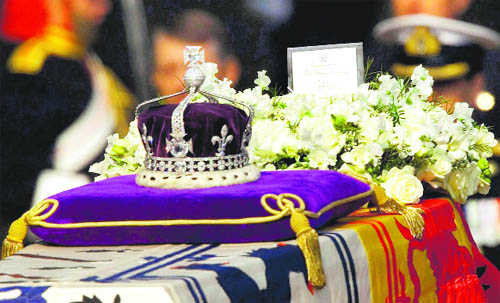
Jupinderjit Singh in Chandigarh
Somewhere deep inside the 11th century Tower of London castle, which was the residence of the British monarchy several times in the history of over 1,000 years, the famed diamond, Kohinoor, is kept as a guarded jewel mounted in the royal crown of the Queen.
The Kohinoor (Mountain of Light) got its modern name from Nader Shah in 1739. Much before that it is described in Sanskrit texts as Symantaka or Samantik Mani, which meant prince and leader among the diamonds. The first Mughal King, Babur, described its worth as equal to the half the value of a day's food for the entire world. In 2015, its worth was quoted as about 100 billion pounds.
Resting in glass cases are several crowns and thrones from several parts of the world including India, Iran and Afghanistan. The Kohinoor is one of them, but is not worn. It is claimed that the real Kohinoor is hidden somewhere in England and only a glass replica is shown to the tourists, but this too is a closely guarded secret.
Over 100 CCTV cameras, about 40 especially trained yeoman guards, apart from sensors and scores of others keep a watch at every moment of an estimated seven lakh tourists visiting the castle every year. Among scores of jewels kept in the block number 3, known as the Waterloo Block, there is one that is on every one's lips - the Kohinoor.
No sparkle
"Not a big deal," said a friend of mine who had migrated to London a few years ago. Like most Indians visiting the city cruising the famous Thames, he recalled the first thing he wanted to see was Kohinoor. And like him, my first impression of the diamond was the same: no big deal. Kept inside a 5-cm-thick glass case, the Kohinoor is placed in the Queen's crown in a row along with other crowns embedded with different diamonds, rubies and precious stones. No one is allowed to even pause for a moment near the glass cases. An escalator keeps moving and as you cross the Queen's crown, you don't even realize which of them is Kohinoor. I could see it only on the second round of the escalators, which is allowed as along as one doesn't stop anywhere.
The diamond never actually sparkled much. It was its size, over 600 carats, (some historians claimed it was 793 carats weighing over 150 grams) that made it so invaluable. The British after acquiring it complained that there was no sparkle. Queen Victoria got it cut to 105 carats and wore it in her crown in 1852, three years after the East India Company got is possession as spoils of war from the treasury of the late Sikh ruler, Maharaja Ranjit Singh.
The Monarchy believed a curse that the diamond carried: It brought bad luck for men who wore it. The curse dates back to a Hindu text. It reads: "He who owns this diamond will own the world, but will also know all its misfortunes. Only God, or a woman, can wear it with impunity."
The origin
No one is yet to claim the diamond's full authentication, such as its origin. From folklore, to historical references to scientific claims, the diamond has confounded everyone. In British possession since 1850, the Kohinoor had not stayed permanently with anyone. Its longest possession was with the Mughals who kept it for over 200 years. There was a mention of large diamonds in some Sanskrit texts: from being a prized possession of Lord Krishna to claims that it was found on the body of Karna, the son of Sun God, as narrated in the Hindu epic, The Mahabharata.
For the record, the diamond's journey starts from the 13th century. It was in the possession of the Raja of Malwa (Kakatiya dynasty). It was described as oval shaped. If the mythical origin is kept aside, the diamond could have originated from the Rayalaseema, meaning the Land of Stones, in the Guntur district under the Golconda kingdom.
Interestingly, diamonds were mined only in India till 1730s when similar mines were discovered in Brazil. The westerners had no exposure to the gems and stones till a Frenchman Jean-Baptiste Tavernier travelled to India in the 17th century. In his book Travels to India, he writes that there were 23 mines in the Kingdom of Golconda.
The Kakatiya dynasty lost to Alaudin Khilji in 1310. Till then, it was called Samantik Mani. Khilji and later rules at the Delhi Sultanate possessed it till about 1526 when Mughal King Babur won it. The precious stone was once embedded in the famed Peacock Throne. When Nadir Shah invaded Delhi in 1739, the diamond is said to have been his key target.
The defeated ruler Muhammad Shah had kept the diamond hidden in his turban. Shah took the ruse of a custom: demanding switching the turbans as a mark of friendship. Nadir Shah could own it for about eight years; he was assassinated. His son also could not keep it for long and when ousted in a coup, he is said to have chosen death by torture than disclosing the whereabouts of the diamond.
Eventually, General Ahmed Shah Durrani found it. His descendant Shah Shuja Durrani was mentioned in some texts as wearing the diamond in a bracelet in 1808 at ceremonial occasions in Peshawar. Durrani later lost his rule in a coup led by Mahmud Shah. But he managed to flee and got protection under Mahraja Ranjit Singh. It is said that in return of the favour, he gifted the diamond to the First Sikh ruler.



























